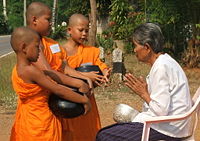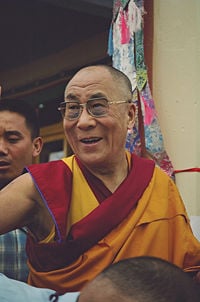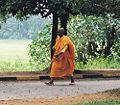|
People of the Pali canon | |
| Pali | English |
|
Community of Buddhist Disciples | |
| Monastic Sangha | |
|
Bhikkhu,¬†BhikkuŠĻáńę | |
| Laity | |
|
UpńĀsaka,¬†UpńĀsikńĀ |
Lay devotee (m., f.) |
|
Related Religions | |
|
SamaŠĻáa | |
A Bhikkhu (PńĀli), or Bhiksu (Sanskrit), is a fully ordained male Buddhist monastic. Female monastics are called Bhikkhunis. The holy orders in Buddhism connect back to the central roots of Buddhism, the original followers of Buddha. When Prince Siddhartha chose to follow the ascetic path to find the truth, giving up his worldly position, and became Buddha, he set up a community of monks, Bikkhu sangha Sanskritt, Bhiksu, and nuns, Bikkhuni sangha, to help with the work of teaching the Dharma (Buddhist teachings). Bhiksu may be literally translated as "beggar" or more broadly as "one who lives by alms." Bhikkhus and Bhikkhunis keep many precepts: They live by the vinaya's framework of monastic discipline, the basic rules of which are called the patimokkha. The original rules and regulations of the monastic orders, called the patimokkha, were set out by the Buddha himself, then adapted over time to keep step with changes in the world. Their lifestyle is shaped so as to support their spiritual practice, to live a simple and meditative life, and attain Nirvana, the goal of all Buddhists.
In addition to pursuing their own spiritual advancement, Bhikkhu and Bhikkuni also stand in a position of leadership to the Buddhist community among which they live. Other members of the spiritual community look to them as an example, for guidance, and for understanding. This is one of the reasons that strict training and discipline are required in the process of becoming a monk or nun in the Buddhist or any other faith. It is important for those in positions of leadership to maintain a high standard of faith and set a good example in their words and actions.
Introduction
Bhikkhu may be literally translated as "beggar" or more broadly as "one who lives by alms." One of the most complete collection of teachings about the proper course for Buddhist monks and nuns can be found in the PńĀli Canon, a collection of scriptures in the Theravada Buddhist tradition. Scholars do not agree about whether this information came directly from Buddha himself, or was formulated by early followers, based on Buddha's teachings. The PńĀli Canon describes a Bhikkhu as "the person who sees danger (in samsara or cycle of rebirth)." He, therefore, seeks ordination as a monk in order to release from it. One passage from the Dhammapada section of the canon states:
Not therefore is he a bhikkhu
Merely because he begs from others.
Not by adopting the outward form
Does one truly become a bhikkhu.
He who wholly subdues evil,
Both small and great,
Is called a monk (bhikkhu)
Because he has overcome all evil (Dhp 266, 267).
A bhikkhu has taken a vow to enter the Sangha (Buddhist monastic community) and is expected to obey rules of conduct (typically around 227 for a male) as set out in the Vinaya, although there are considerable local variations in the interpretations of these rules. A novice monk or nun in the Tibetan tradition takes 36 vows of conduct. The minimum age to take bhikkhu vows is 21 years (although this also varies from country to country).
The establishment of a monastic community meant that the greater community of Buddhist faithful could be described in four groups: Male and female lay believers, and Bikku (Bhikkhu in pali and Bhikshu in Sanskrit), and Bikkhuni (Bhikkuni in Pali and Bhikshuni in Sanskrit), the male and female ordained monks. Joining the ranks of the ordained is the highest goal of Buddhist practitioners. The monks and nuns are the pillars of the community of faith, spreading Buddhist teachings and serving as living examples for the lay believers to follow. Also, by serving as a field of merit, they give laymen the opportunity to gain merit by supporting the ordained community with donations of food and money. The disciplined life in the monastic order also contributes towards the monks' and nuns' pursuit of the liberation of Nirvana through the cycle of rebirth.
Monks and nuns
In English literature prior to the mid-twentieth century, Buddhist monks were often referred to by the term bonze, particularly when describing monks from East Asia and French Indochina. This term is derived via Portuguese and French from the Japanese word bonsŇć for a priest or monk, and has become less common in modern literature.[1] Although the European terms "monk" and "nun" are applied also on Buddhism, the situation of "ordination" in Buddhism is more complicated, involving several levels of commitment.
In Buddhism, monkhood is part of the system of "vows of individual liberation." These vows are taken by monks and nuns from the ordinary sangha, in order to develop personal ethical discipline. In Mahayana Buddhism, the term "sangha" is, in principle, restricted to those who have achieved certain levels of understanding. They are, therefore, called "community of the excellent ones" (Tib. <mchog kyi tshogs>). These, however, need not be monks and nuns (that is, hold such vows).
Monks usually traveled in small groups, living at the outskirts of the village. The monks depended on donations of food and clothing from the residents of the village. Part of Buddha's direction was that the members of the monastic order gather in larger groups and live together during the rainy season. The dwellings where they stayed during these times were also to be given voluntarily by people from the community. Over time, the dwellings became more permanent, the monks settled in regions; their lifestyle became less nomadic, and the monks started to live communally in monasteries. The patimokka, rules governing life in the monastery, were developed, prescribing in great detail the way to live and relate in a community. For example, the patimokka in the Theravada branch of Buddhism contains 227 rules.
Joining the order
The vows of individual liberation are taken in four steps. A lay person may take the five vows called "approaching virtue" (in Tibetan genyen <dge snyan>). The next step is to enter the monastic way of life (Tib. rabjung <rab byung>) which includes wearing monk's or nun's robes. After that, one can become a novice or samanera (Skt. shramanera, Tib. getsh√ľl <dge tshul>). The last and final step is to take all the vows of a "fully ordained monk" or gelong Tib. (<dge long>). Gelongma (<dge long ma>) is the female term. The translation from Sanskrit is bikshuni (female) or bikshu (male). The Pali term is bhikkhuni (female) or bhikkhu (male), used in Theravada Buddhism (Sri Lanka, Burma, Thailand).
Laymen who wish to join the order must approach a monk who has been in the order for at least ten years, and ask to be taken in. First ordained as a samanera (novice), they have their heads shaved, and begin to wear the robes appropriate to the order they have joined. For a period of at least a year, they must live by the Ten Precepts‚ÄĒrefraining from sexual contact, refraining from harming or taking life, refraining from taking what is not given, refraining from false speech, refraining from the use of intoxicants, refraining from taking food after midday, refraining from singing, dancing, and other kind of entertainment, refraining from the use of perfume, garland and other adornments, refraining from using luxurious seats and refraining from accepting and holding money. They are not required to live by the full set of monastic rules. Boys from eight years old can be ordained as samanera. Women are usually first ordained when adults. From the age of 20, samanera can be ordained to the full level of Bikkhu or Bikkhuni.
The Buddha instructed that in order to be ordained as Bikkhu or Bikkhuni, the applicant need to have a preceptor. The preceptor is usually the elderly monk that ordained the applicant as samanera. The samanera needs to approach a community of at least ten monks of at least ten years standing each and who are well respected for their virtues and learning. The monks would then ask the applicant eleven questions to assess his readiness, suitability and motives: (1) Are you free from disease? (2) Are you a human being? (3) Are you a man? (4) Are you a free man? (5) Are you free from debt? (6) Do you have any obligations to the king? (7) Do you have your parents' permission? (8) Are you at least twenty years of age? (9) Do you have your bowl and robe? (10) What is your name? (11) What is your teacher's name? If the applicant answers satisfactorily to these questions, he/she will request ordination three times and if there is no objection from the assembly, he/she is considered a monk/nun.
Monks and nuns take their vows for a lifetime, but they can "give them back" (up to three times in one life), a possibility which is actually used by many people. In this way, Buddhism keeps the vows "clean." It is possible to keep them or to leave this lifestyle, but it is considered extremely negative to break these vows.
In Tibet, usually small children from 6 onwards can take the rabjung ordination which is a child-specific approach to monastic life. At age 14, they usually take getsh√ľl ordination which includes more rules, and after age 21, many take the gelong ordination‚ÄĒor prefer to quit the monastic life.
Hierarchy among monks
In most branches of Buddhism, there are no formal rules that define a hierarchy within the monastery. However, tacit rules of obedience to the most senior member of the Sangha, and other rules stemming from the teacher/student, senior/junior and preceptor/trainee relationship are at work within the monastery. Decisions to be taken concerning life in the monastery are usually done in communal meetings.
The daily running of the monastery is in the hand of an abbess or abbot who may appoint assistants. The position of abbess / abbot are usually held by one among the senior members of the monastery. In some case he/she will be elected by the members of the order, and in other cases the lay community will choose him/her.
Women were not originally included in the ascetic community by the Buddha. However, after incessant pressures from his aunt and stepmother, Maha Pajapati Gotami, he accepted the ordination of women. Stronger restrictions and rules were put on the communities of nuns, however, such as the precedence of monks over the nuns in matter of respect and deference, the prohibition of nun teaching monks, and that the confession and punishment of nuns should be done before a joint assembly of both nuns and monks.
Robes
The special dress of ordained Buddhist monks and nuns, the robes, comes from the idea of wearing cheap clothes just to protect the body from weather and climate. They shall not be made from one piece of cloth, but mended together from several pieces. Since dark red was the cheapest colour in Kashmir, the Tibetan tradition has red robes. In the south, yellow played the same role, though the color of saffron also had cultural associations in India; in East Asia, robes are yellow, grey or black.
In Tibet, there are pronounced differences in the robes of monks at various stages of their vocation. One difference is that rhe robes of getsh√ľl novices do not include the "holes" that can be found in the robes of gelong monks. Some monks tear their robes into pieces and then mend these pieces together again. The younger rabjung novices do not wear the "ch√∂-g√∂√∂," or yellow tissue worn during Buddhist teachings by both getsh√ľls and gelongs.
Adherants of Buddhism in many countries have traditions of special robes as part of the observance of the Kathina festival, which traditional comes at the end of the rainy season. To celebrate Kathina, a special Kathina robe is made in 24 hours from donations by lay supporters of a temple. The robe is donated to the temple or monastery, and the resident monks then select from their own number a monk to receive this special robe. The monk is selected from those who have observed a special three month period of retreat and meditation during the rainy season. [2]
Marriage and celibacy
Celibacy was a requirement for the members of the Buddhist orders, as established by Buddha. Even up until today, in some branch of Buddhism this rule is still in effect. However, as the Buddha was a pragmatic teacher and the rules he set for the monastic life prone to change, he predicted, as women were ordained that the rule of celibacy will not hold for more than 500 years. In fact, since the seventh century in India, some groups of monks were getting married. In Japan, from the Heian period (794-1105 C.E.), cases of monks getting married started to appear. However it was during the Meiji restoration, from the 1860's that marriage by monks was officially encouraged by the government. Since that time, Japan remains the country with the largest number married monks among the higher orders. Marriage by monks is also practiced in other country, including Korea and Tibet.
Tantric vows
A lay person (or a monk/nun) engaging in high tantric practices and achieving a certain level of realization will be called a yogi (female "yogini," in Tibetan naljorpa/naljorma <rnal hbyor pa/ma>). The yogis (monks or lay) observe another set of vows, the tantric vows (together with the bodhisattva vows); therefore, a yogi/yogini may also dress in a special way, so that they are sometimes called the "white sangha" (due to their often white or red/white clothes). Both ways, tantric and monastic are not mutually exclusive; although they emphasize different areas of Buddhist practice, both are ascetic.
Other vows
There are still other methods of taking vows in Buddhism. Most importantly, "Bodhisattva vows" are to be taken by all followers of Mahayana Buddhism; these vows develop an altruistic attitude. Another "centering of self" method is taking strict one-day vows which are somewhat similar to monk's/nun's vows ("Mahayana precepts"), but last only from one sunrise to another sunrise.
Conclusion
Ordination in Buddhism is a cluster of methods of self-discipline according to the needs, possibilities and capabilities of individuals. According to the spiritual development of his followers, the Buddha gave different levels of vows. The most advanced method is the state of a bikkhu(ni), a fully ordained follower of the Buddha's teachings. The goal of the bhikku(ni) in all traditions is to achieve liberation from suffering.
Beside that, the Mahayanist approach requires bodhisattva vows, and the tantric method requires tantric vows. Since some people are not attracted to monk/nun ordination, all other vows can be taken separately. On the other hand, it is said that one cannot achieve the goal without taking the vows of individual liberation‚ÄĒthat is, comply with the ethical disciple inscribed in these vows.
Gallery
See also
Notes
- ‚ÜĎ Dictionary.com, Bonze. Retrieved September 24, 2008.
- ‚ÜĎ A.G.S. Kariyawasam, Monastic Ceremonies: Vassa and Kathina, Buddhist Ceremonies and Rituals of Sri Lanka. Retrieved September 24, 2008.
ReferencesISBN links support NWE through referral fees
- Ashwaghosh, and Harishchandra Lal Singh. The Life of a Monk. Kathmandu: Bhikshu Ashwaghosh, 2003. OCLC 56095862
- Bstan- ľdzin-rgya-mtsho. Advice from Buddha Shakyamuni Concerning a Monk's Discipline: An Abridged Exposition of the Bhikshu's Precepts. Dharamsala, India: Library of Tibetan Works & Archives, 1986. OCLC 43014309
- Inwood, Kristiaan. Bhikkhu: Disciple of the Buddha. Bangkok: Thai Watana Panich, 1981. OCLC 8490186
- Roscoe, Gerald. The Monastic Life: Pathway of the Buddhist Monk. Bangkok, Thailand: Asia Books, 1992. OCLC 29415903
External links
All links retrieved October 1, 2023.
- The Bhikkhus' Code of Discipline
- Lay Guide to the Monks' Rules
- THE BHIKSHU (MENDICANT) The Dhammapada online.
| |||||||||||||||||||||||||||||||||||||||||||
Credits
New World Encyclopedia writers and editors rewrote and completed the Wikipedia article in accordance with New World Encyclopedia standards. This article abides by terms of the Creative Commons CC-by-sa 3.0 License (CC-by-sa), which may be used and disseminated with proper attribution. Credit is due under the terms of this license that can reference both the New World Encyclopedia contributors and the selfless volunteer contributors of the Wikimedia Foundation. To cite this article click here for a list of acceptable citing formats.The history of earlier contributions by wikipedians is accessible to researchers here:
The history of this article since it was imported to New World Encyclopedia:
Note: Some restrictions may apply to use of individual images which are separately licensed.












